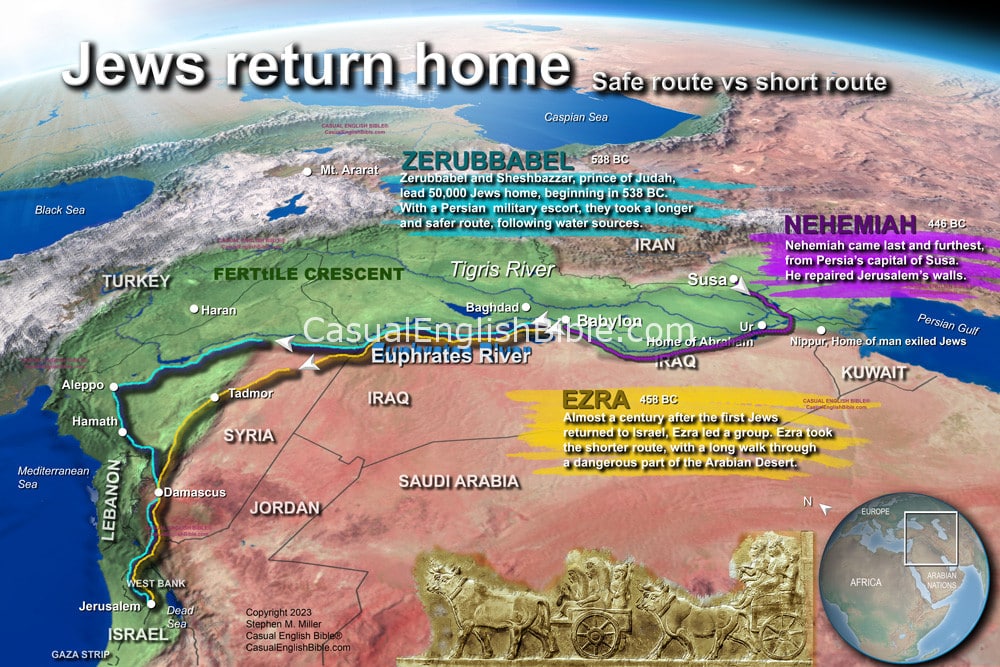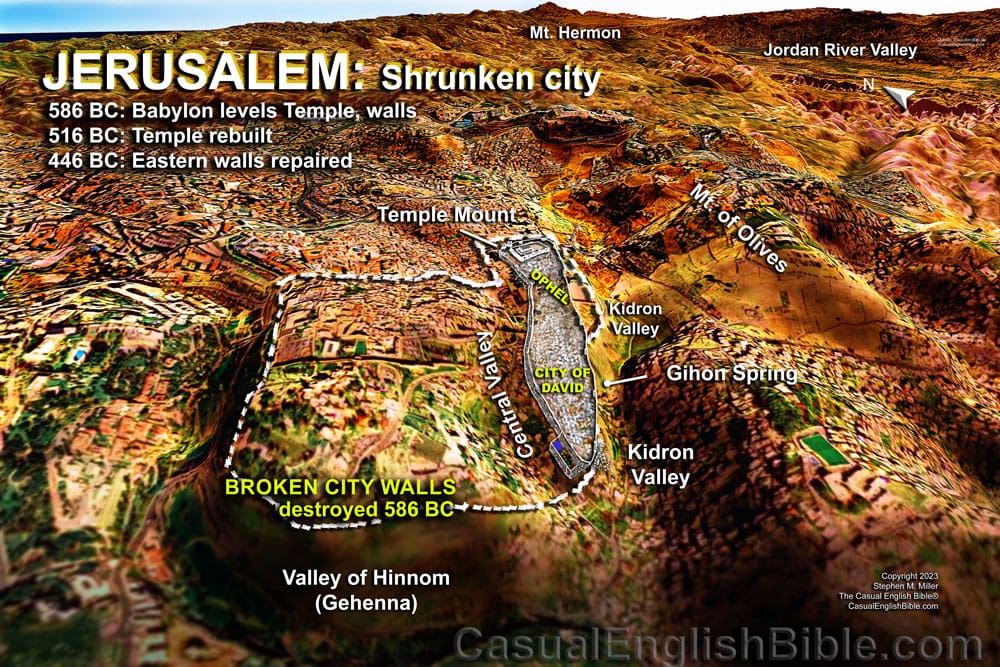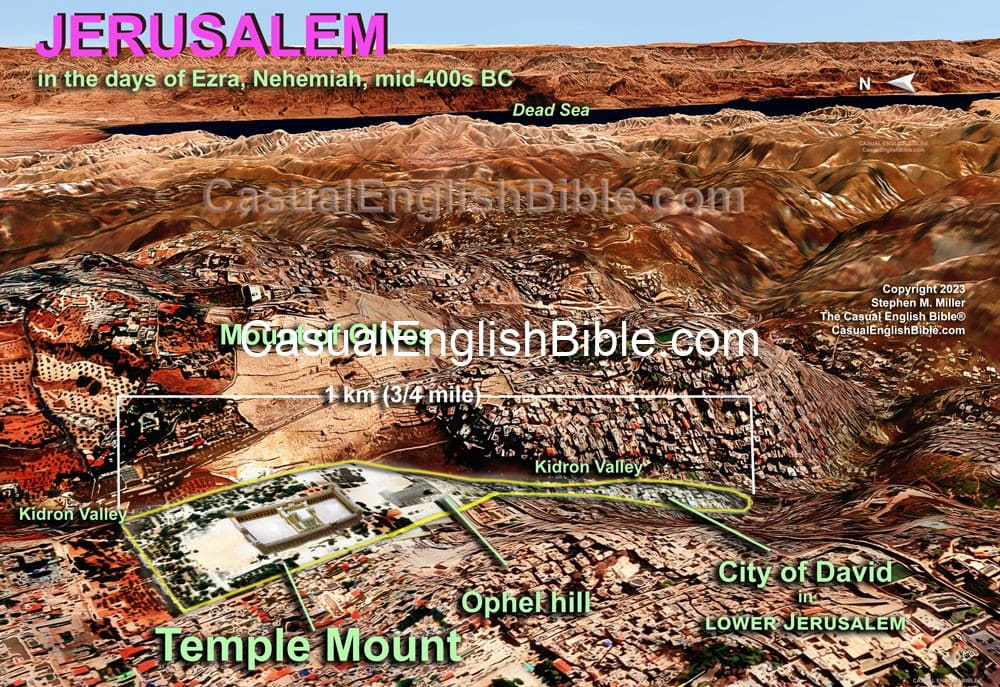Ezra 3
Jews build the Temple foundation
First official Jewish sacrifices in half a century
1Jews who came back to Israel from exile met in Jerusalem during the fall. This was in the seventh month on the Jewish calendar. [1] 2The people wanted to offer sacrifices to God again, as the laws of Moses said they should do. [2] So, the top priest, Jeshua son of Jozadak, started building a new altar over the ruins of the old one. He worked with his associate priests. Zerubbabel son of Shealtiel helped, too, and so did some of his family.3As newcomers, the returning Jews were afraid of the locals. So, they quickly set up the altar where it had been before, and they sacrificed to God every morning and night. 4They observed the Last Harvest Festival. [3] Every day of the festival they sacrificed the animals, grain, and olive oil that the law required. [4]
5After this sacred holiday, the Jews continued their ancient practice of offering sacrifices each day. They did the same for all the special religious events, such as the beginning of each new moon along with all the other sacred holidays on the calendar. People also brought sacrificial gifts just because they wanted to, as freewill offerings.
6This was before anyone started rebuilding the Temple or the foundation. Even without a Temple, the people kept bringing their offerings to the altar. This started on the day the altar was rebuilt, on the first day of the seventh month.
Construction workers wanted
7To prep for rebuilding the Temple, people gave money to hire stonemasons and carpenters. And they paid merchants from Sidon and Tyre to transport [5] cedar trees from Lebanon to Joppa. King Cyrus of Persia covered the cost with a grant. The people added their own donations in food, wine, and olive oil.8Jews started work on the Temple in the springtime, almost a year and two months after they got back from exile. [6] Leading the work were the governor, Zerubbabel son of Shealtiel, and the top priest, Jeshua son of Jozadak. Other Jews helped, including priests and their associates, the Levites. Every Levite man 20 years old and older directed some phase of the work.
9Priests and Levites with their families supervised the workers. Among the bosses were Jeshua and his sons and others in his family, Kadmiel and his sons, Binnui and Hodaviah, [7] and Henadad’s sons.
Celebration: roaring cheers, screaming tears
10When they finished laying the foundation, they celebrated. Priests dressed in their formal robes. Then they expressed thanks to God by blowing rams’ horns. Levites from the family of Asaph joined in, playing the cymbals. The people did this to follow King David’s instructions [8] for how to celebrate construction of the first Temple. 11They thanked the LORD and praised him with their music:“He is so good to us.
His love never wavers.
His love never ends.
He is so good to Israel.”
12But there were a lot tears among the cheering crowd. Some old-timers who had seen the first Temple started crying. Some priests, Levites, family leaders, and the elderly began to weep. As loud as some were cheering for joy, others wept [9] and sobbed at the sight of the new Temple’s foundation. 13Sounds of cheering and crying churned into one rolling roar of thunder that people could hear from far away. But it was impossible to distinguish laughter from sobbing.
Footnotes
The month was called Tishri, about August/September. It was an important month. King Solomon dedicated the first Jewish Temple then. It was also the month Jews celebrated two sacred holidays. There was Yom Kipper (the Day of Atonement), which was the holiest day of the year—a day of fasting. And there was the Last Harvest Festival, often called the Festival of Shelters or Festival of Booths. In Exodus, it was the last harvest festival of the year, when farmers harvested late-season crops such as grapes, figs, and olives (Exodus 23:16). This was in the late summer and early autumn. The Hebrew word describing the festival here is sukka. It can mean tent, canopy, or temporary shelter. Moses said God wanted the Israelites to observe this festival by building temporary shelters and living in them for seven days “so you and your descendants will remember that the people of Israel I led out of Egyptian slavery once lived in shelters like this” (Leviticus 23:43). For a group of people newly returned from another exodus—exiled to what is now Iraq—this was a relevant memorial.
Jews hadn’t been able to sacrifice animals to God for half a century. Babylonians leveled the Jerusalem Temple in 586 BC, and the altar there was the only place Jews could sacrifice (Deuteronomy 12:5; 2 Chronicles 6:6). So, they needed a new altar at the Temple site to reinstate their practice of sacrificial worship. Then they would rebuild the Temple after that.
Better known as the Festival of Shelters or Festival of Booths. See footnote for 3:1.
See Numbers 29 for the long list of Late Harvest Festival sacrifices.
They probably didn’t carry the logs from Lebanon to Jerusalem. More likely, they did what loggers had done for the first Temple, which Solomon built. They built them into rafts and floated them down the Mediterranean Sea’s coastline to Joppa, the closest thing Israel had to a port city (2 Chronicles 2:16). Tyre to Joppa is about 85 miles (135 km). Floating from Sidon, further north, they had to add another 25 miles (40 km). Once the logs reached Joppa, workers hauled the lumber over land another 35 miles (55 km) from Joppa (now Jaffa/Tel Aviv) to Jerusalem.
Work started in the second month on the Jewish calendar, Ziv (mid-April to mid-May). That’s the month King Solomon started building the first Temple (2 Chronicles 3:2).
This could also be translated as the “men of Judah.”
See 1 Chronicles 16.
The writer doesn’t say why the older folks are crying. Haggai 2:3 offers the possible hint that his tiny slab of a foundation might have seem pitifully little compared to Solomon’s majestic Temple: “Some of you have been around long enough to remember what my house used to look like. What do you think of the Temple now? Does it look like anything more than a pile of rocks?” Yet some chose to see the positive and hope for the best, “As for those folks who complain about how small the Temple looks in the beginning, wait until they see Zerubbabel get busy with a plumb line at the walls” (Zechariah 4:10).
Discussion Questions
- Sorry, there are currently no questions for this chapter.








